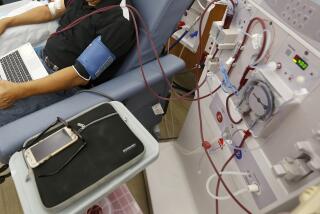From Daughter, With Love
- Share via
For the most part, Karen and Saba Torabi of Woodland Hills share a typical mother-daughter relationship.
One passes along words of wisdom as the other shares her dreams for the future. One remembers her youth as the other blossoms into womanhood. One nurtures while the other is nurtured.
But their roles reversed Friday when daughter Saba donated one of her kidneys to her mother, giving the elder woman--in the words of her husband--”a second life.”
On Sunday, mother and daughter reunited for the first time since the surgery at USC University Hospital in Los Angeles.
Sitting in a wheelchair, Saba Torabi smiled broadly at her mother as she lay in bed in the intensive care unit. Woozy from surgery and medication, Karen managed to return her daughter’s smile.
Both women were progressing as expected, hospital officials said. The daughter could be released as early as Wednesday, followed by her mother’s return home a few days later.
In an interview before the surgery, Karen, 53, said, “My daughter is priceless. There are no words to explain what she is doing for me.”
Saba, 18, said she decided to go through the procedure because she could no longer bear to see her mother so sick and weak. “I’m just happy that she will be feeling OK again,” she said.
Because she was so concerned about her mother’s weak condition, Saba began tissue, blood, urine and antibody testing even before she turned 18, the minimum age at which a person is eligible to donate an organ, on Sept. 28.
The Cal State Northridge freshman biology major was the fourth relative to attempt donation, family members said. Her father, Hooshang Torabi; sister Katayoun, 22, and her mother’s brother were tested, but none matched.
Some 12,200 patients underwent kidney transplants in the United States in 1996, according to the latest statistics provided by the National Kidney Foundation of Southern California.
Acceptable (living) donors are usually between ages 18 and 60 and are most often parents, siblings or offspring of the recipients, foundation officials said. Prospective donors must be in good health and have compatible blood and tissue types.
Once Saba recovers from surgery, she can expect to live a normal life. Donating a kidney will not interfere with her ability to have children and will not change her life expectancy or increase her chances of kidney failure, experts said.
Karen was put on daily dialysis after her kidneys failed two years ago when she was living in Visalia.
“It suddenly happened,” she said. “My face was swollen and I went to the hospital because of the swelling. . . . I went into a coma for 10 days. When I came out of the coma, they told me my kidneys had failed.”
The family moved to Los Angeles when Karen’s husband took a job as a marketing director for a Glendale computer company.
Saba’s kidney donation was an early holiday gift: “My daughter asked me, ‘What can I get you for Christmas?’ I said, ‘You have to be kidding me. You have already given me my gift.’ ”
“Giving that kidney is like giving my wife a second life,” Hooshang said, fighting tears after the surgery on Friday. “There are no other words for it.”
*
The donation began at 7:30 a.m. Thursday, when Hooshang drove his wife and daughter from their home to the hospital. There, Saba underwent final tests to assess her readiness for surgery.
That evening, the Torabis gathered in a fifth-floor hospital room with family and friends who offered one another encouraging words about the impending surgery.
On Friday morning, Saba was wheeled from the hospital room and taken to the surgical area one floor below. There, she received an epidural anesthetic to numb her lower body and a catheter was inserted in case she required fluids during surgery. A thimble-sized monitor was placed on her left index figure to monitor her oxygen level.
Meanwhile, Karen remained in the room and chatted quietly with a friend about her daughter’s birth in Iran during war with Iraq. She noted the irony that Iraq was the enemy once again at a time when she was experiencing a rebirth of sorts.
She also told visitors she had cried late into the night because she was worried about Saba’s surgery and whether her daughter’s quality of life would be diminished.
Shortly after 7:30 a.m., Saba was wheeled into Operating Room 1 and lifted onto the operating table. An anesthesiologist held a mask over her nose and mouth until she drifted into unconsciousness.
After a brief delay while the surgical team waited for Saba’s X-rays, donor surgeon Rafael Mendez cut through her skin, revealing the marbled muscle beneath.
At 8:50 a.m., Mendez told the circulating nurse to call for Karen to be taken to Operating Room 4 so she could be prepared to receive her daughter’s kidney.
Mendez’s twin brother, Robert, who is also a kidney transplant surgeon, walked into the room to check on Saba’s progress. His interest was more than just casual: He was going to implant the organ into Karen’s abdomen.
“A kidney donation is like a pebble dropped into a pond,” Robert Mendez said to a reporter as he watched his brother work. “This is not just a gift to the mother, but to the nation because it saves a kidney for national pool recipients who don’t have a family donor.”
As for Saba, he said, long after her life has ended, her children and grandchildren will remember her as the family member “who gave her kidney to save her mother’s life.”
About a half-hour later, Rafael Mendez removed the kidney and handed it to Dr. Robert M. Naraghi, who placed it in a machine filled with sodium chloride. The machine gently raised and lowered the organ, flushing it of blood, urine and other fluids and packing it with ice.
Surgeons then placed the kidney in a stainless steel pitcher and carried it down a short hall to Operating Room 4, where Karen was already prepped and anesthetized.
Once the organ was ready for transplantation, Robert Mendez made an incision in Karen’s abdomen. Kidneys are removed from the back but implanted through the front.
“There is a 95% chance it will take,” Mendez said, manipulating sutures, clamps, scissors and a suction tube. “A year from now she will be doing just fine. Her life expectancy will improve, but more importantly her quality of life will be greatly improved.”
At 10:30 a.m., Mendez finished attaching the artery from Saba’s kidney to a major blood vessel that runs through Karen’s right leg.
“OK. Let’s see what we’ve got here,” he said, removing a clamp. Blood flowed into the organ, swelling it and turning it pink, and giving Karen a fully functioning kidney for the first time in two years.
“That’s good,” Mendez said. “Nothing like a young, beautiful kidney. Why can’t we all just take a pill and get back to 18 again?”
More to Read
Sign up for Essential California
The most important California stories and recommendations in your inbox every morning.
You may occasionally receive promotional content from the Los Angeles Times.










